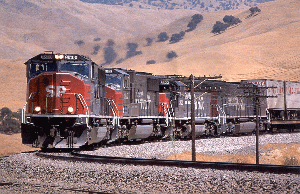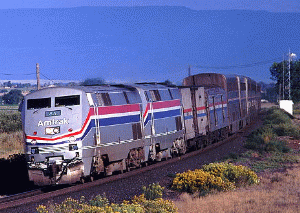Different traffic function results in different infrastructure
| Road | Sea (domestic/intra-EU) | Rail | Inland Waterways | Pipelines |
|
|---|---|---|---|---|---|
| EU 15 | 44.5 % | 40.4 % | 8.0 % | 4.1 % | 3.0 % |
| USA | 29.0 % | 7.7 % | 36.9 % | 9.5 % | 16.4 % |
One look at traffic statistics shows two main differences in freight transport, when comparing the USA and the EU:
- The high importance of railfreight in the USA.
- The high importance of seafreight in the EU.
Bulk freight, or large amounts of containers, or large amounts of chemicals go by sea in Europe, and by rail in the USA. Main reason is the different continent shape, but there are also regulative issues, like the Jones Act in the USA. Under European conditions, it is realistic to leave the bulk loads to the open sea, and try to compete with trucking instead. Under US conditions, all price-sensitive goods on transcontinental routes are "natural railfreight". Result: Successful US freight railroads and successful European freight railroads are completely different operations.

Where huge amounts of freight are moved up a grade, superelevation of tracks in the USA is close to zero.
Successful European freight railroads, like in Switzerland, Austria and Sweden, use rather fast operating speeds, and certain trains or train systems are set up to beat trucks in speed and reliability. In contrast, US railroads compete mostly by price, just like the intra-EU freight traffic on seagoing vessels.
Another difference is the importance of passenger traffic and freight traffic. The German railway network sees 7000 - 8000 freight trains per day, but 30,000 - 40,000 passenger trains. Most of the US network has no passenger traffic, or 2 Amtrak trains per day. Optimizing the infrastructure for passenger traffic is supported by very different economic facts in Europe.
Results in Railroad Operation
In European operation, the high density of passenger trains usually means, that tracks with a capacity problem have a rather high minimum speed, like 45 mph uphill. This results in high costs per mile for the freight traffic, and does not allow US freight transport prices.

On the 2.7% of the Lötschberg, a major European north-south route, freight is usually moved at 47 mph.
In contrast, uphill speeds of US freight operations might get close to bicycle speed. While this allows low operating costs, it is almost impossible, to push an hourly or halfhourly fast passenger train through this kind of operation. The same is true for express freight. Switzerland has an overnight express railfreight system on distances, that are completely ignored by US railroads, for lack of profitability.
Results in Railroad Infrastructure
The bigger the difference in speed, the bigger the problem of designing the right railway infrastructure, especially in curves. Fast operation calls for high superelevation, but slow, heavy freight trains shift their weight on the innermost rail then, causing high wear and high maintenance cost. Therefore, high differences in speed can require compromising about superelevation. Very high superelevation might be found on dedicated passenger traffic lines only, or on lines with high priority for passenger traffic.

If a freight railroad operates on flat ground, and if the mix of trains includes "hot" intermodals, superelevation values are
compatible with passenger train operation.
The slow uphill speeds of US freight trains have resulted in rather low superelevation in mountain areas. High superelevation is found only, where the railroad wants to speed up "hot" intermodals on rather flat ground. (In reality, superelevation might be even lower than explained in this article, for the simple reason, that nobody bothered to calculate the equilibrium value for heavy freight.)
Since the 1950s, when the railroads still ran their own prestige passenger trains, superelevation has been lowered on many routes in the USA. This is one of the reasons, why the Amtrak trains of today are often slower than passenger trains of the 1950s.